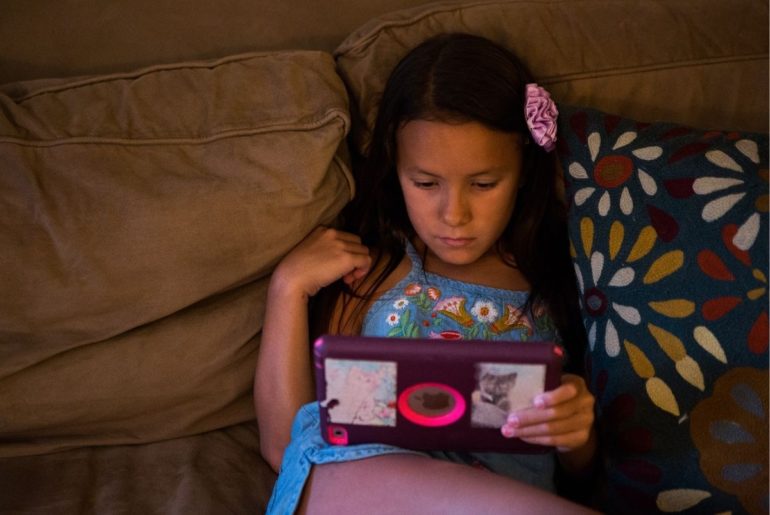When it comes to online safety for kids, open communication is crucial. Most parents are aware of the potential dangers to kids online — but the fact is, it’s a digital age and most kids need online access for everything from school to socialization.
We can use “safe search” browsers and parental controls, but what if our kids still encounter something disturbing or inappropriate online? April is National Child Abuse Prevention Month, but it’s always good time to educate ourselves — and our kids — about what to do if they see abuse, harassment, or violence on their device.
Here’s how to make sure your child will come to you right away if they see something bad online — and exactly what to do and say.
Explain what to look out for.
One of parents’ biggest worries is that our kids will see something problematic online—and not tell us. So to make sure you stay in the loop, first teach your child what they should look out for—but in an age appropriate way.
As adults, we know that kids might see pictures of child sexual abuse (sometimes called CSAM or child pornography), violent acts, signs of abuse, hate speech, or harassment and bullying. Depending on your kid’s age though, that might sound scary or confusing. Kids might also think that only whatever specific examples we use “count” as inappropriate—so it can help to be a little more general.
Here are kid-friendly things to say about online safety:
“The internet is full of fun and interesting things. But not everything there is as safe as it should be. When you’re online, you might see something that’s inappropriate or upsetting.”
“If you find something that makes you feel icky, scares you, or that you think kids probably shouldn’t see, it’s important for you to tell me or another adult you trust right away.”
Next, you’ll want to make sure your kid knows why something that makes them uncomfortable might show up on their screen. Here’s what to say…
“Sometimes bad stuff shows up because the computer misunderstood what you were trying to search for, or a link took you someplace you didn’t mean to go. Sometimes people get curious about something, and before they know it they end up seeing yucky stuff.”
“Other times, a person you know or a stranger might send you something online, ask for a photo, or talk in ways that make you uncomfortable.”
Of course you can “age up” the exact wording for older kids. The idea is to make sure kids know that inappropriate stuff is out there, and they should tell you about it. But how can you be sure they will?
Reassure them.
Make sure your child’s comfortable coming to you when they need to by emphasizing that they’re not to blame and won’t get in trouble:
“No matter how it happens, seeing inappropriate words, videos, or pictures online is not your fault.”
“I’ll NEVER be mad at you for finding something upsetting online. You won’t be in trouble, and I won’t take your device away. I just want you to tell me, so we can handle it together.”
What to do if your child sees something inappropriate:
- Ask about it. Find out why it made them uncomfortable to determine what support they need.
- Take action. “Let’s see if we can report this video/post/article so other kids don’t have to see it.” Never reshare problematic content. Even if you’re sharing it in a parenting group with a message like, “I can’t believe this, it’s terrible!” it only serves to boost that content in the online algorithms, which ensure even more people see it.
- Comfort them. “I’m always here for you, and I’m sorry this was so upsetting. Do you want a hug?”
- Find an alternative. If it makes your child feel safer, block the problematic site so they won’t run into it again. If the content came from a person, block and report them, too. Then help your child get back on track to find what they were looking for in the first place.
View this post on Instagram
Next steps
- Be aware of the apps, sites, and platforms your child uses. Bad stuff can show up almost anywhere, but some sites and apps (especially those that allow kids to chat with strangers) are riskier than others.
- Finally, if you or your child find suspected online enticement, abuse, or sexual exploitation of a child, obscene material sent to a child, a misleading domain name or misleading words or images on the internet that lead to such content—file a report with the National Center for Missing and Exploited Children (NCMEC) online at www.cybertipline.com, or call 1-800-843-5678.
Learn more about online safety for kids with our info hub for parents and caregivers.
View this post on Instagram







